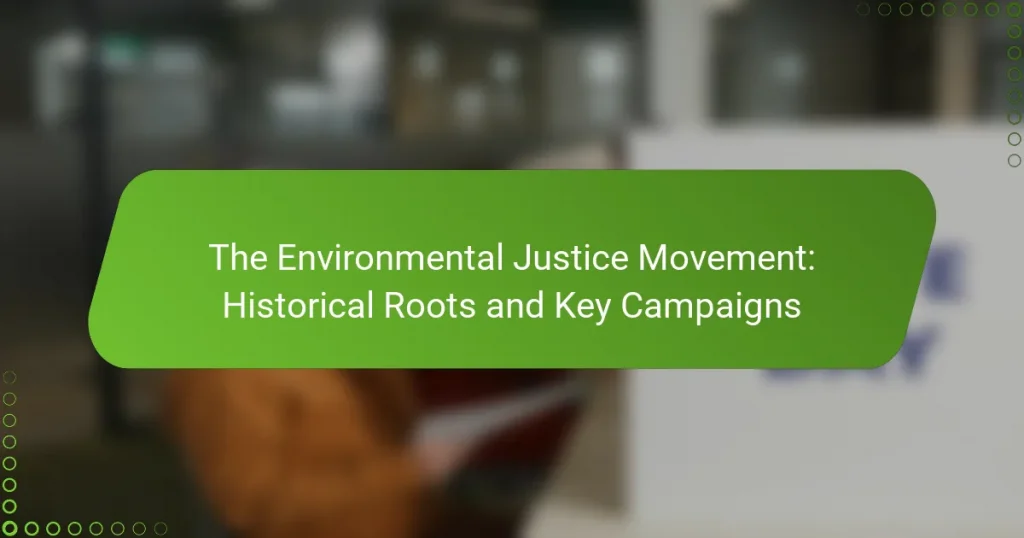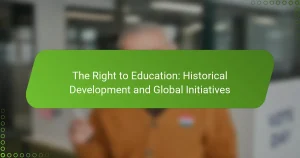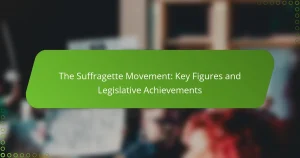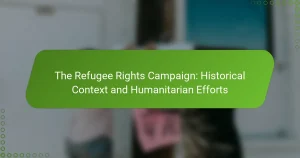The Environmental Justice Movement addresses the unequal environmental burdens faced by marginalized communities, focusing on the intersection of environmental issues and social justice. Originating in the United States during the 1980s, this movement gained prominence through key events like the 1982 Warren County protests against toxic waste disposal. It advocates for equitable distribution of environmental benefits and burdens, ensuring that all communities, regardless of race or income, have a voice in decision-making. The movement has evolved to address broader issues, including climate change and sustainable practices, while raising awareness about environmental racism and its impacts on low-income and minority populations. Key campaigns, such as the Dakota Access Pipeline protests and the Love Canal incident, underscore the ongoing fight for environmental equity.

What is the Environmental Justice Movement?
The Environmental Justice Movement seeks to address the disproportionate environmental burdens faced by marginalized communities. It emerged in the United States during the 1980s, highlighting the links between environmental issues and social justice. Activists advocate for equitable distribution of environmental benefits and burdens. They aim to ensure that all communities, regardless of race or income, have a voice in environmental decision-making. Key events, such as the 1982 protests in Warren County, North Carolina, brought national attention to the issue. The movement has since expanded globally, influencing policies and raising awareness about environmental racism. Studies show that low-income and minority communities often face higher exposure to pollution and environmental hazards. The movement continues to evolve, addressing climate change and advocating for sustainable practices.
How did the Environmental Justice Movement originate?
The Environmental Justice Movement originated in the United States during the 1980s. It emerged in response to the disproportionate impact of environmental hazards on marginalized communities. The 1982 protests in Warren County, North Carolina, against a toxic waste landfill marked a pivotal moment. Activists highlighted how low-income and minority neighborhoods faced greater exposure to pollution. This sparked increased awareness and advocacy for equitable environmental policies. The movement sought to address systemic inequalities in environmental protection. It emphasized the need for inclusion of affected communities in decision-making processes. The establishment of the First National People of Color Environmental Leadership Summit in 1991 further solidified the movement’s goals and principles.
What historical events contributed to the formation of the Environmental Justice Movement?
The Environmental Justice Movement was shaped by several key historical events. The 1969 Santa Barbara oil spill raised public awareness about environmental degradation. In 1982, the Warren County PCB landfill protests highlighted environmental racism. The 1991 First National People of Color Environmental Leadership Summit united diverse communities. The 1994 Executive Order 12898 mandated federal agencies to consider environmental justice. These events collectively mobilized grassroots activism and shaped policies addressing environmental inequalities.
Who were the key figures in the early days of the Environmental Justice Movement?
Key figures in the early days of the Environmental Justice Movement include Dr. Benjamin Chavis, who coined the term “environmental racism.” He played a significant role in mobilizing communities against environmental hazards. Another key figure is Hazel Johnson, known as the “mother of environmental justice.” She founded the People for Community Recovery in Chicago, addressing pollution in low-income neighborhoods. Additionally, Robert Bullard is recognized as a leading scholar in environmental justice. His research highlighted the connection between race and environmental issues. These individuals were instrumental in raising awareness and advocating for policy changes in the movement. Their efforts laid the groundwork for future activism and legislation.
Why is the Environmental Justice Movement important?
The Environmental Justice Movement is important because it addresses the disproportionate impact of environmental hazards on marginalized communities. This movement advocates for equitable distribution of environmental benefits and burdens. It seeks to ensure that all individuals, regardless of race or income, have the right to a healthy environment. Historically, marginalized communities have been more likely to reside near toxic waste sites and polluting industries. Studies show that low-income and minority populations face higher exposure to air and water pollution. The movement raises awareness of these injustices and promotes policy changes. It empowers affected communities to fight for their rights. Ultimately, the Environmental Justice Movement fosters a more inclusive approach to environmental policy.
What impact does environmental injustice have on communities?
Environmental injustice negatively impacts communities by exposing them to higher levels of pollution and environmental hazards. This often leads to increased health risks, such as respiratory diseases and other chronic conditions. Communities of color and low-income areas are disproportionately affected due to systemic inequities. For example, a study by the U.S. Environmental Protection Agency found that minority populations face greater exposure to air pollutants. Additionally, environmental injustice can undermine economic opportunities by reducing property values and limiting access to resources. This cycle perpetuates poverty and hinders community development. The cumulative effects of these factors can result in significant social and economic disparities.
How does the Environmental Justice Movement address systemic inequalities?
The Environmental Justice Movement addresses systemic inequalities by advocating for equitable distribution of environmental benefits and burdens. It highlights how marginalized communities often face disproportionate environmental hazards. The movement seeks to empower these communities through grassroots organizing and policy change. It emphasizes the importance of including affected populations in decision-making processes. Research shows that low-income and minority groups are more likely to be located near hazardous waste sites. This disparity has led to increased health risks for these populations. By raising awareness, the movement aims to rectify these injustices and promote sustainable practices. Legal actions and community-led initiatives are often employed to challenge environmental racism.
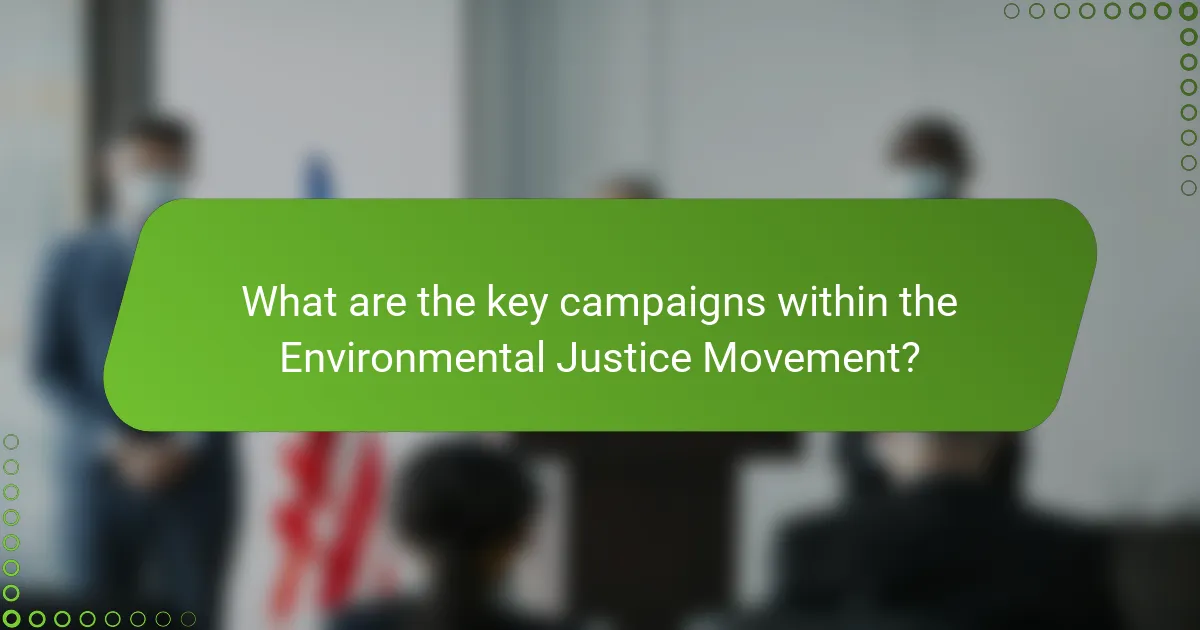
What are the key campaigns within the Environmental Justice Movement?
Key campaigns within the Environmental Justice Movement include the 1982 Warren County protests, which opposed toxic waste disposal in a predominantly African American community. These protests highlighted environmental racism and sparked national awareness. Another significant campaign is the fight against the Dakota Access Pipeline, where Indigenous groups protested against potential water contamination. The Love Canal incident in the late 1970s also played a crucial role, as residents fought against hazardous waste exposure. The movement has addressed issues like air pollution in urban areas and industrial waste in marginalized communities. Each campaign emphasizes the intersection of environmental issues and social justice.
Which campaigns have had the most significant impact?
The campaigns with the most significant impact in the Environmental Justice Movement include the Love Canal incident, the Warren County protests, and the Standing Rock Sioux Tribe’s opposition to the Dakota Access Pipeline. The Love Canal case in the 1970s highlighted the dangers of toxic waste exposure. It led to national attention on hazardous waste sites and the establishment of the Superfund program. The Warren County protests in 1982 marked the first major grassroots mobilization against environmental racism. This campaign raised awareness about the disproportionate siting of hazardous waste facilities in minority communities. The Standing Rock protests in 2016 united various tribes and activists against the Dakota Access Pipeline, emphasizing indigenous rights and environmental protection. These campaigns collectively influenced policy changes and heightened public awareness of environmental justice issues.
What strategies were employed in the Love Canal campaign?
The Love Canal campaign employed grassroots organizing, public awareness, and legal action. Grassroots organizing involved mobilizing local residents to confront the environmental hazards in their community. Public awareness was raised through media coverage and community meetings, highlighting the health impacts of toxic waste. Legal action included lawsuits against the Hooker Chemical Company and government agencies for negligence. These strategies resulted in significant media attention and the eventual evacuation of affected families. The campaign also led to the establishment of the Superfund program in 1980, aimed at cleaning up hazardous waste sites.
How did the Standing Rock protests influence public perception of environmental justice?
The Standing Rock protests significantly influenced public perception of environmental justice. They highlighted the intersection of indigenous rights and environmental protection. The protests drew global attention to the Dakota Access Pipeline and its potential environmental risks. Activists emphasized the importance of clean water and land rights. This raised awareness about the broader implications of environmental policies on marginalized communities. Social media played a crucial role in mobilizing support and spreading information. The protests spurred discussions on corporate accountability and government responsibility. As a result, many people began to view environmental justice as a critical social issue. The Standing Rock movement galvanized a new generation of activists focused on environmental and indigenous rights.
What role do grassroots organizations play in the Environmental Justice Movement?
Grassroots organizations are vital to the Environmental Justice Movement. They mobilize communities affected by environmental injustices. These organizations advocate for policy changes and raise awareness about local issues. They often provide a platform for marginalized voices. Grassroots groups also foster community engagement and empowerment. They lead campaigns that challenge corporate practices harmful to the environment. For example, the 1982 protests in Warren County, North Carolina, highlighted the struggle against toxic waste sites. This activism helped catalyze the broader Environmental Justice Movement. Their efforts have been instrumental in shaping policies that address environmental disparities.
How do local communities mobilize for environmental justice?
Local communities mobilize for environmental justice through grassroots organizing, advocacy, and coalition-building. They often identify specific environmental issues affecting their neighborhoods, such as pollution or lack of access to clean water. Community members hold meetings to raise awareness and develop action plans. They may collaborate with local organizations to amplify their voices. Public demonstrations and campaigns are organized to draw attention to their causes. Legal actions can also be pursued to challenge unjust practices. Research shows that community-led efforts lead to significant policy changes. For example, the 1991 People of Color Environmental Leadership Summit helped solidify the environmental justice movement.
What challenges do grassroots organizations face in their campaigns?
Grassroots organizations face several challenges in their campaigns. Limited funding restricts their ability to reach wider audiences. Many grassroots groups rely on donations, making financial sustainability difficult. Additionally, they often encounter bureaucratic hurdles when seeking permits or support from local governments. Competition from larger organizations can overshadow their efforts. Lack of access to media can hinder their visibility and message dissemination. Furthermore, grassroots organizations may struggle with mobilizing volunteers consistently. They also face potential pushback from powerful stakeholders who oppose their initiatives. These challenges can significantly impact the effectiveness of their campaigns.
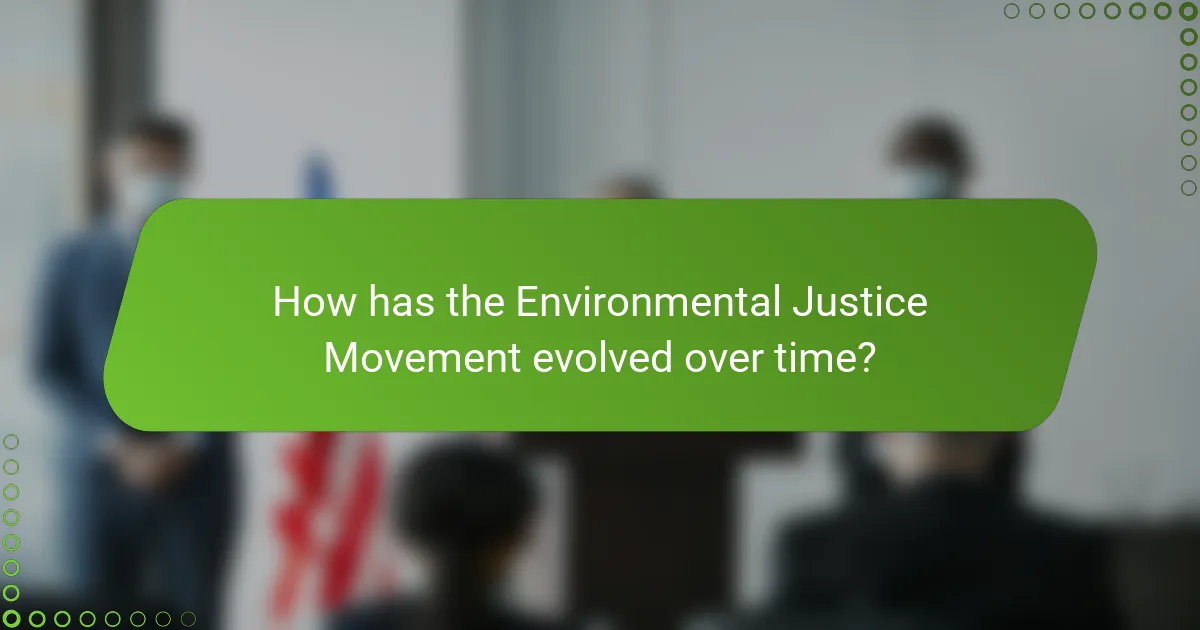
How has the Environmental Justice Movement evolved over time?
The Environmental Justice Movement has evolved significantly since its inception in the 1980s. Initially, it emerged in response to the disproportionate impact of environmental hazards on marginalized communities. The movement gained visibility with the 1982 protests in Warren County, North Carolina, against a hazardous waste landfill. This event highlighted the intersection of race and environmental policy. In the 1990s, the movement expanded its focus to include broader social justice issues and policy reforms. The 1994 Executive Order 12898 by President Clinton emphasized federal attention to environmental justice. In the 2000s, grassroots organizations began to advocate for climate justice as a critical component of the movement. Today, the Environmental Justice Movement addresses global issues like climate change, emphasizing the need for equitable solutions.
What changes have occurred in the focus of the Environmental Justice Movement?
The focus of the Environmental Justice Movement has shifted from localized pollution issues to broader systemic inequalities. Initially, the movement concentrated on the placement of hazardous waste sites in marginalized communities. Over time, it expanded to address climate change, access to clean water, and sustainable development. This evolution reflects a growing recognition of the interconnectedness of environmental and social justice. Recent efforts emphasize the need for policy changes that promote equity in environmental protection. Activists now advocate for inclusive decision-making processes that involve affected communities. This shift highlights the importance of addressing root causes of environmental degradation. The movement now seeks to integrate social, economic, and environmental justice principles.
How has climate change influenced the goals of the Environmental Justice Movement?
Climate change has significantly influenced the goals of the Environmental Justice Movement. The movement now emphasizes the disproportionate impacts of climate change on marginalized communities. These communities often face higher exposure to environmental hazards and less access to resources for adaptation. Climate change has also highlighted the need for equitable distribution of environmental benefits. The movement advocates for policies that address both climate resilience and social equity. Recent studies, such as those by the Intergovernmental Panel on Climate Change, show that vulnerable populations are more affected by climate-related disasters. This has led to an increased focus on inclusive decision-making processes. The movement seeks to empower these communities in climate action initiatives.
What new issues are emerging within the Environmental Justice Movement today?
Emerging issues within the Environmental Justice Movement today include climate change impacts on marginalized communities. These communities often face disproportionate risks from extreme weather events. Another issue is the intersection of racial justice and environmental policy. Advocacy is growing for policies that address systemic inequalities. Additionally, the movement is focusing on the environmental impacts of industrial pollution in low-income areas. Recent studies show that these areas experience higher rates of health problems. The movement is also addressing the need for equitable access to green spaces. Research indicates that urban areas with more green spaces improve community health outcomes. Finally, the rise of digital activism is reshaping how grassroots organizations mobilize support. This shift allows for broader engagement and awareness of environmental justice issues.
What can individuals do to support the Environmental Justice Movement?
Individuals can support the Environmental Justice Movement by advocating for policy changes. They can participate in local government meetings to voice concerns about environmental issues. Engaging in community clean-up events helps improve local environments. Supporting organizations that focus on environmental justice raises awareness and funds. Educating themselves and others about the impacts of environmental racism is crucial. Voting for candidates who prioritize environmental justice influences systemic change. Reducing personal carbon footprints contributes to a healthier planet. Collaborating with marginalized communities amplifies their voices in the movement.
How can community members get involved in local environmental justice initiatives?
Community members can get involved in local environmental justice initiatives by participating in local advocacy groups. These groups often focus on issues like pollution, access to clean water, and equitable land use. Members can attend meetings to learn about current challenges and strategies. Volunteering for clean-up events or educational workshops is another way to contribute. Engaging in public comment periods for local policies can amplify community voices. Collaborating with local leaders helps to build stronger networks for change. Research shows that community involvement leads to more effective environmental policies. According to a study by the Environmental Protection Agency, active community engagement significantly improves project outcomes.
What resources are available for learning more about environmental justice issues?
Books, articles, and online courses are available for learning about environmental justice issues. Key texts include “Dumping in Dixie” by Robert D. Bullard, which examines environmental racism. “The Environmental Justice Reader” offers a collection of essays on the subject. Academic journals such as “Environmental Justice” provide peer-reviewed articles. Websites like the Environmental Protection Agency (EPA) offer resources and reports. Nonprofit organizations like the Sierra Club and the NAACP host educational materials. Online platforms like Coursera and edX feature courses on environmental justice topics. These resources collectively provide a comprehensive understanding of the issues and movements within environmental justice.
The Environmental Justice Movement is a social movement aimed at addressing the unequal environmental burdens faced by marginalized communities, originating in the United States during the 1980s. This article explores its historical roots, key campaigns, and influential figures, highlighting events such as the Warren County protests and the Love Canal incident. It also examines the movement’s evolution to include climate justice, the role of grassroots organizations, and emerging issues within the movement today. Additionally, the article discusses the impact of environmental injustice on communities and provides resources for individuals looking to engage with environmental justice initiatives.
